Abstract
1. We compared the pressure-response characteristics of C fibre and A fibre baroreceptors in the carotid sinus of anaesthetized dogs, recording impulses from the sinus nerve and varying mean pressure in the vascularly isolated sinus, which was distended with a pulsatile pressure. Functional stimulus-response curves were obtained by gradually increasing sinus pressure above and decreasing it below a set-point of 100 mmHg. Baroreceptors were identified by a pulsatile discharge synchronous with the pulsations in sinus pressure. A and C fibre baroreceptors were identified by the conduction velocities and blocking temperatures of their axons. 2. The pressure-response characteristics of C and A fibre baroreceptors differed in several respects. C fibres had a pulsatile firing threshold 50 mmHg higher than that of A fibres (105.8 +/- 1.8 and 54.6 +/- 2.9 mmHg, respectively), an average maximal sensitivity 35% of that of A fibres (0.39 and 1.12 impulses s-1 mmHg-1, respectively), and a maximal frequency (at 220 mmHg) 29% of that of A fibres (24.5 and 84.3 impulses/s, respectively). Although invariably pulsatile at pressures above threshold, the firing pattern of C fibre baroreceptors tended to be more irregular than that of their A fibre counterparts. 3. Impulses were also recorded from C fibres that were stimulated by increasing sinus pressure but had an irregular, non-pulsatile discharge, a high pressure threshold (averaging 154.1 +/- 7.2 mmHg), and a low maximum frequency (10.8 +/- 2.4 impulses/s). 4. Cooling the sinus nerve progressively attenuated conduction in both A and C fibres, A fibres being blocked between 12 and 4 degrees C (mean 6.8 degrees C) and C fibres between 4 and -1.5 degrees C (mean 1.0 degree C). Although cooling the sinus nerve to 7 degrees C did not block conduction in all A fibres, impulse activity in baroreceptor A fibres at a carotid sinus pressure of 200 mmHg was no greater than that at a pressure of 75 mmHg. By contrast, at 7 degrees C baroreceptor C fibres still provided a signal proportional to sinus pressure. 5. Our results suggest that A and C fibre baroreceptors subserve different reflex functions, the former signalling changes in arterial pressure both above and below the normal set-point, the latter only changes above. They also suggest that differential cold blockade may be a useful tool to determine the contribution of C fibre baroreceptors to cardiovascular reflexes.
Full text
PDF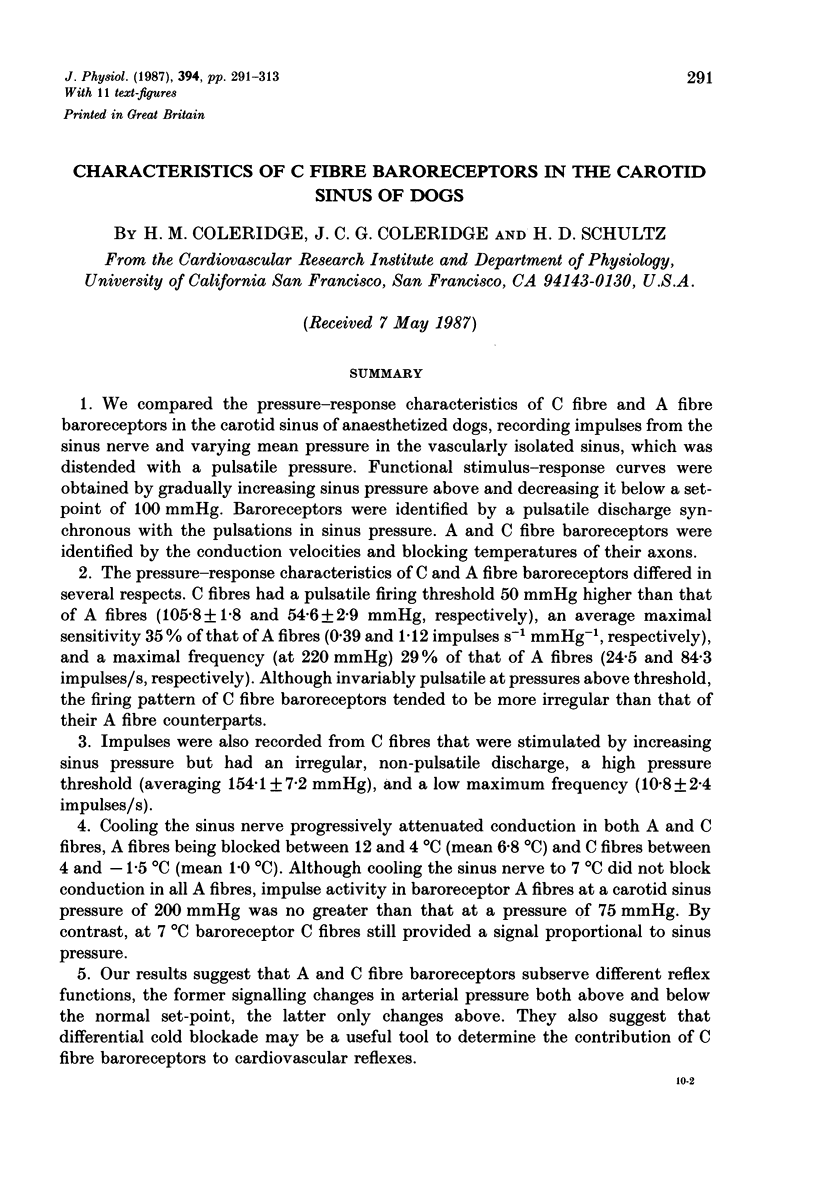
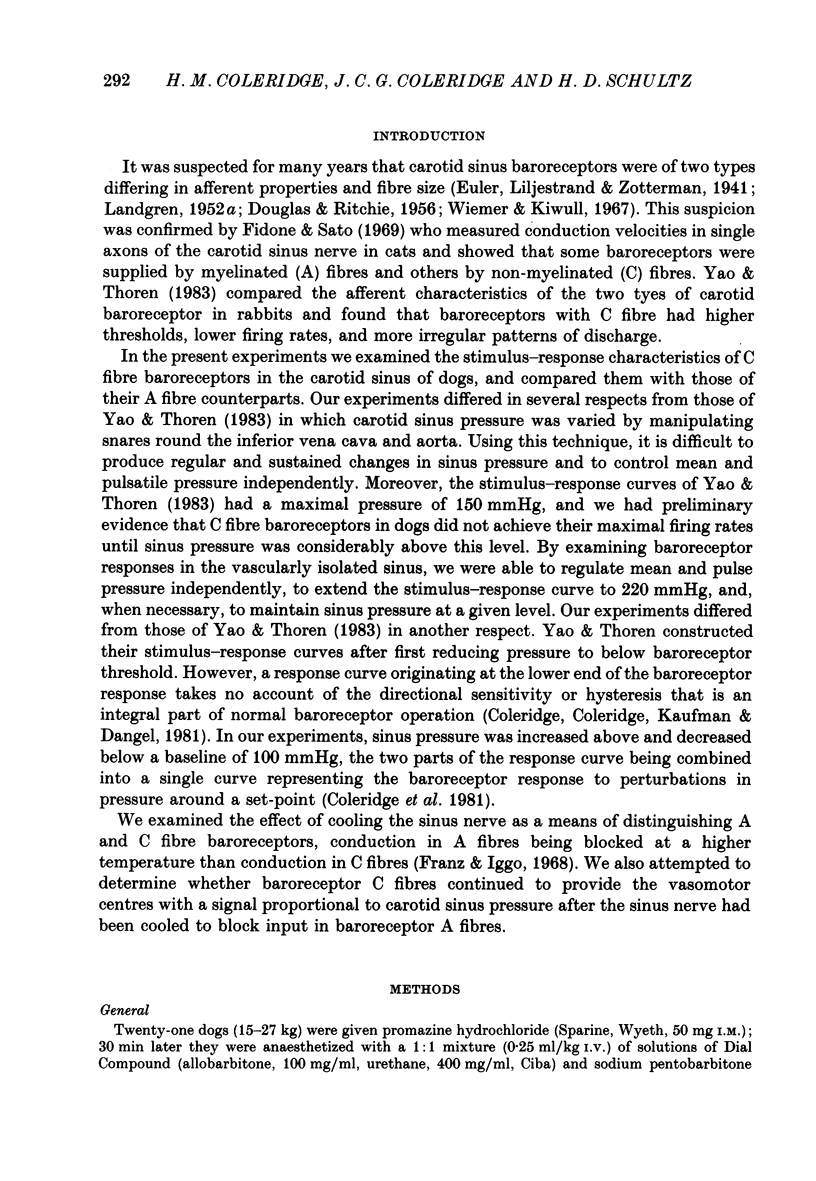
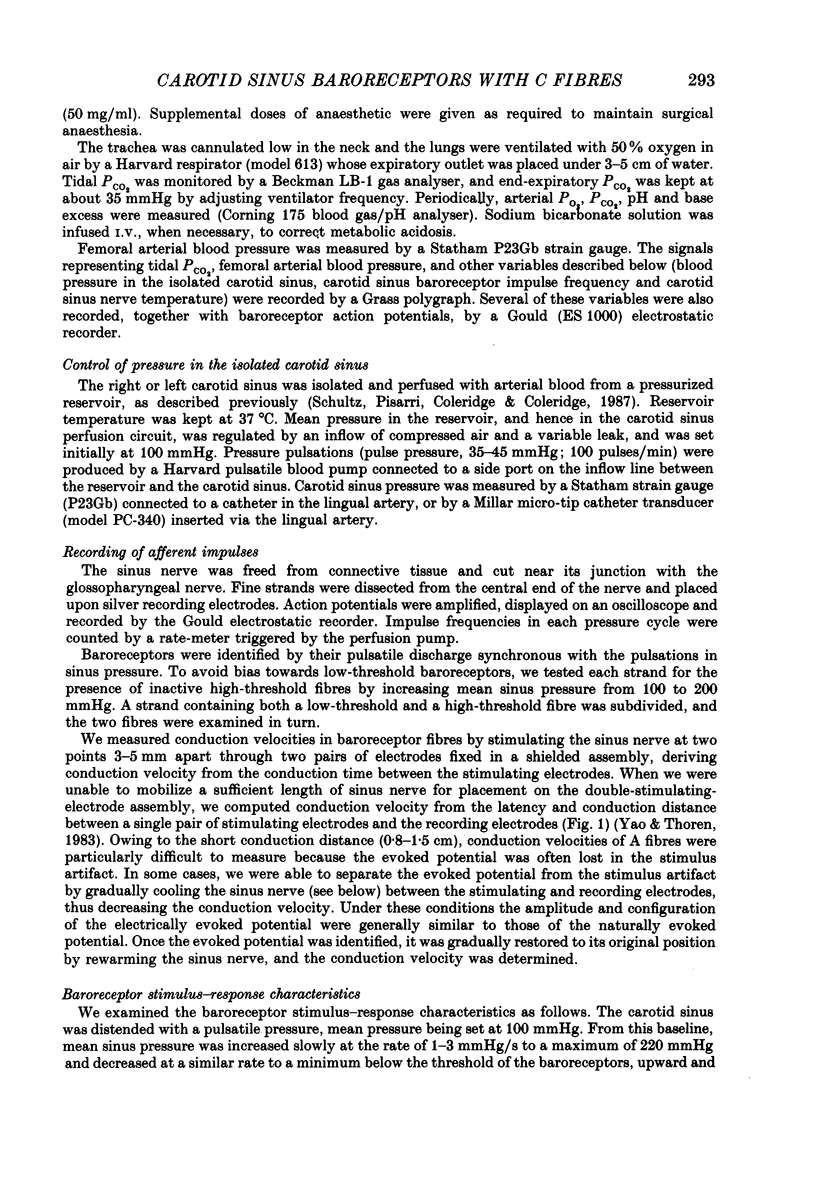
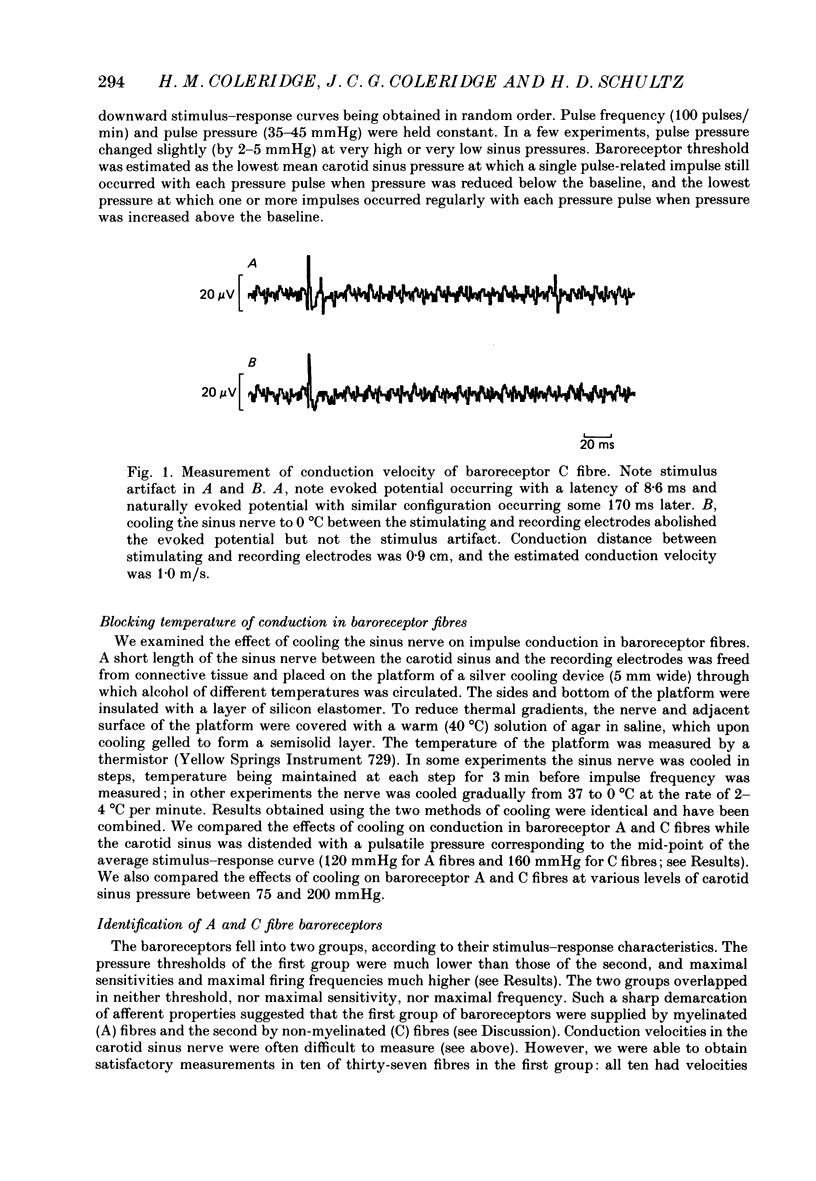
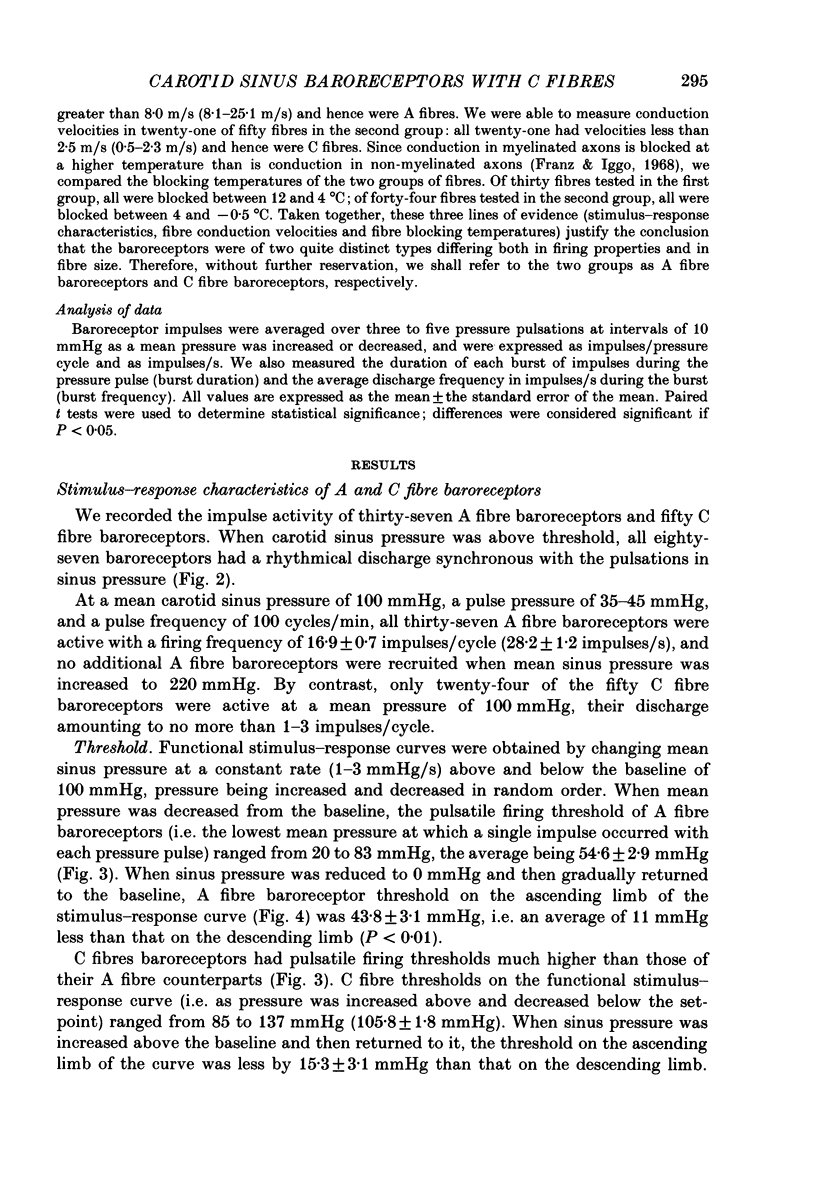
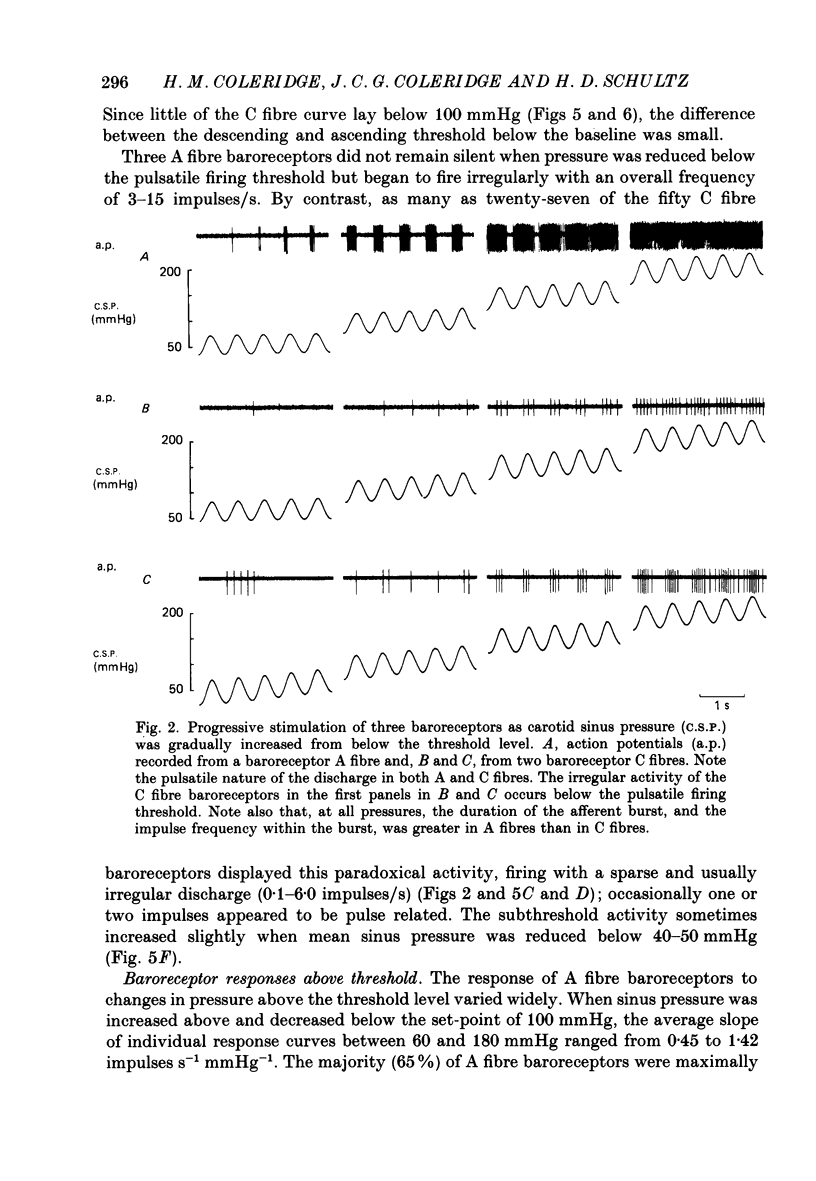
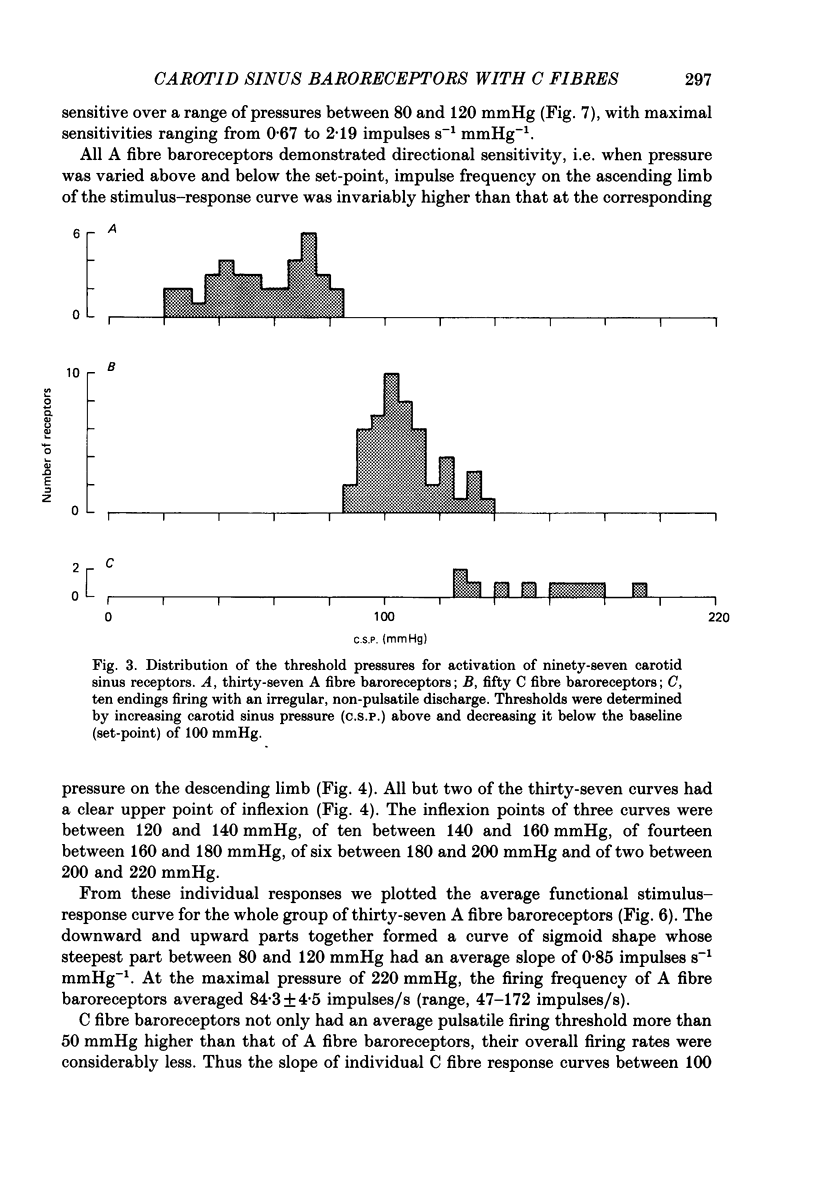
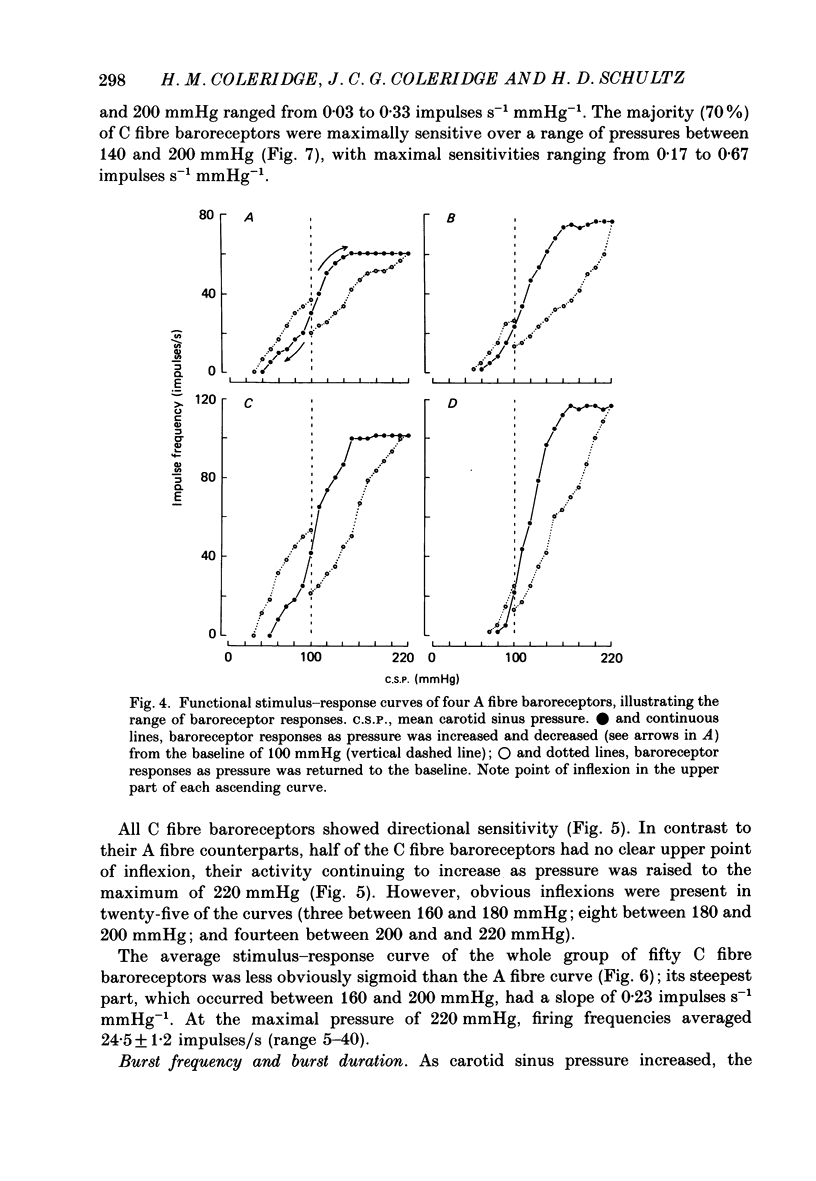
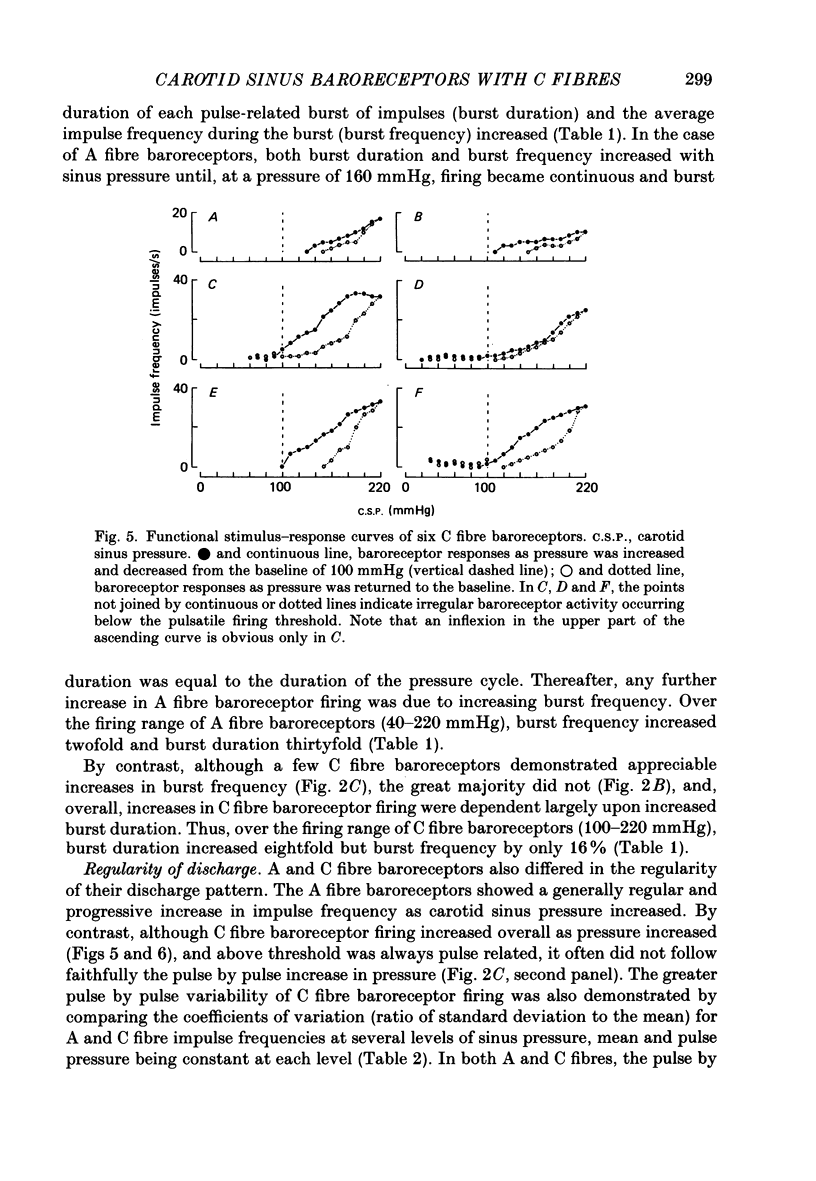
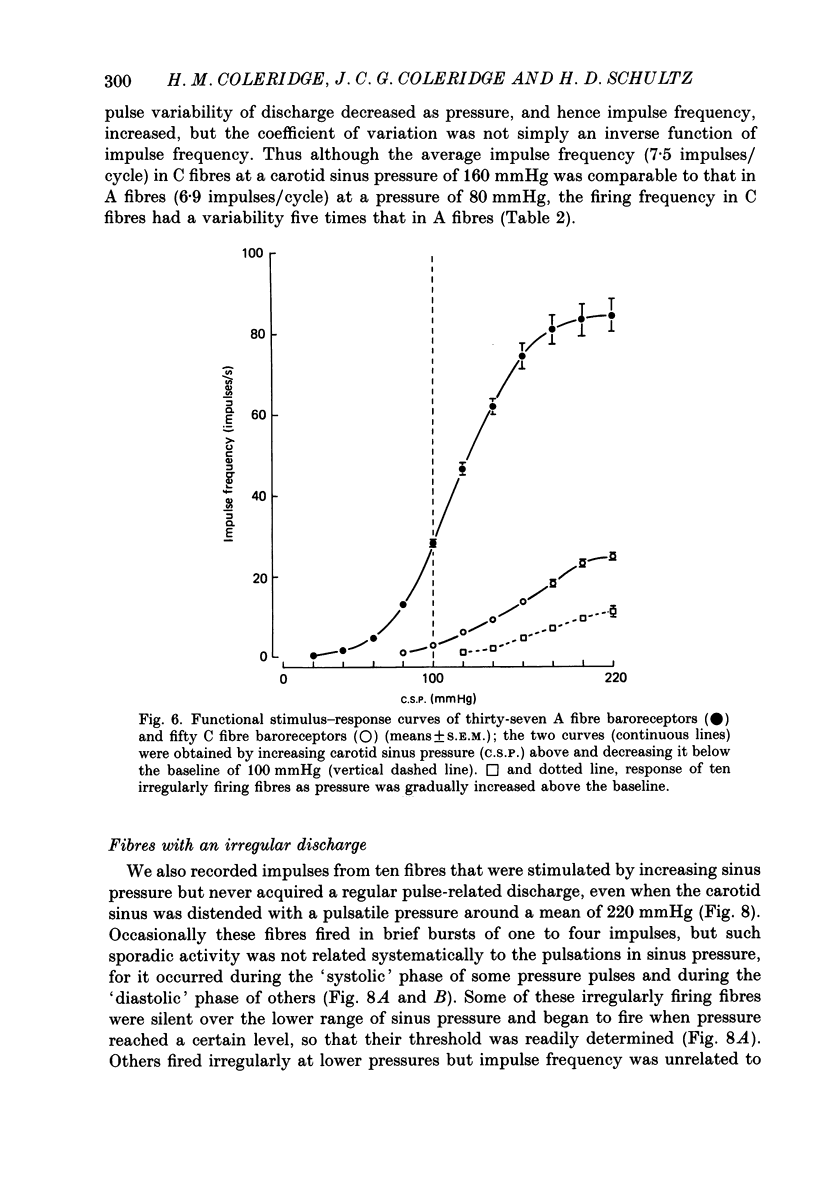
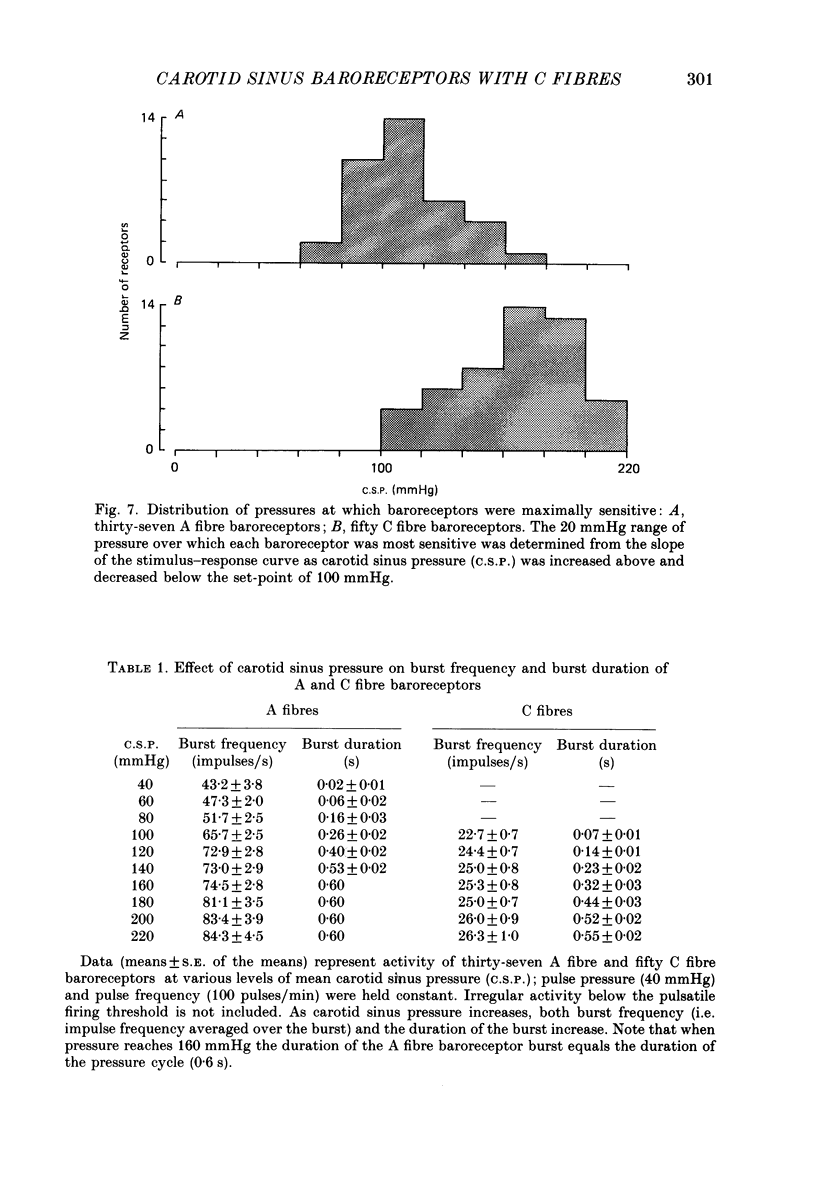
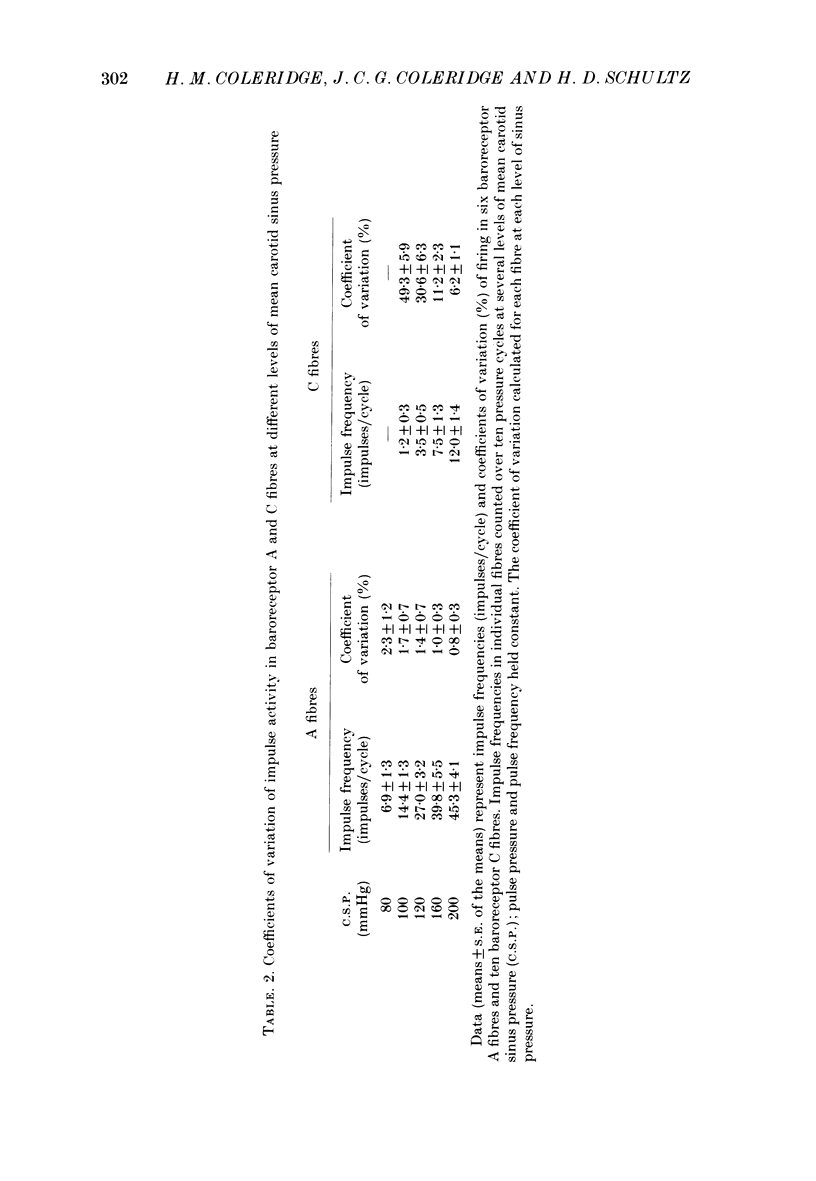
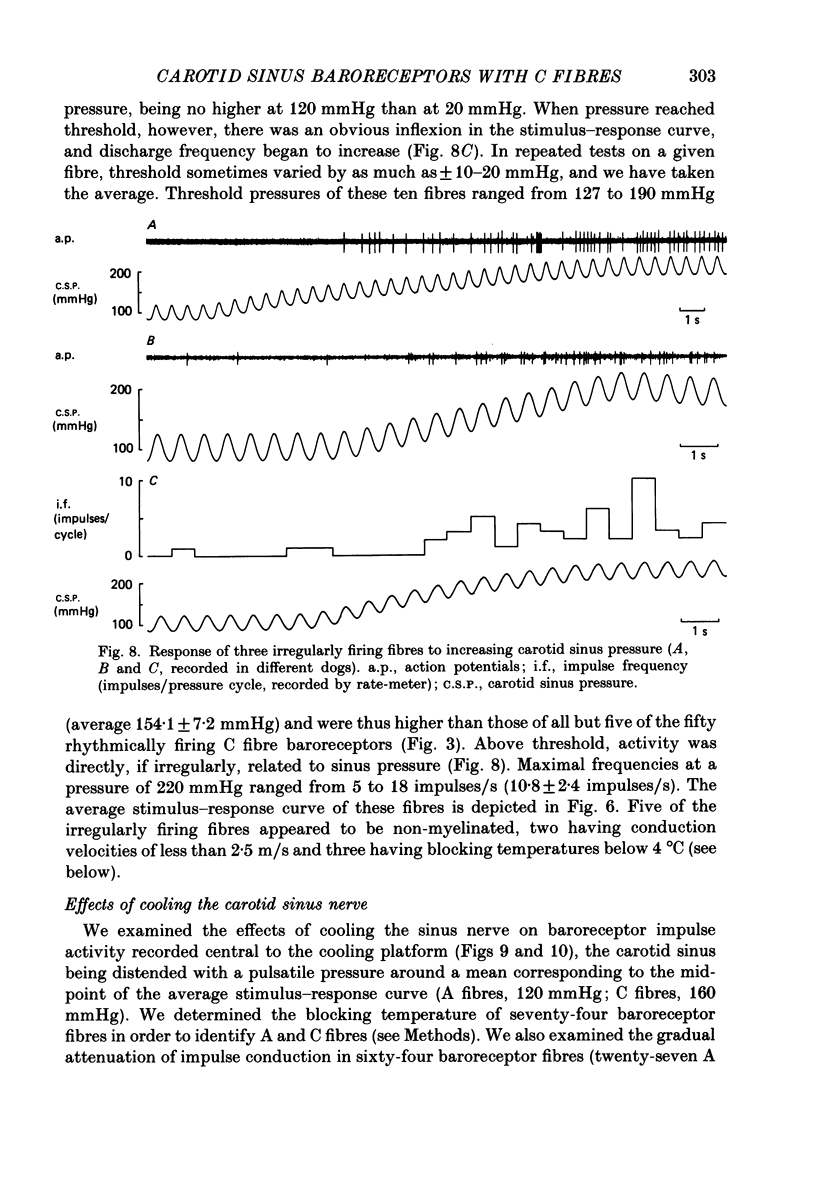
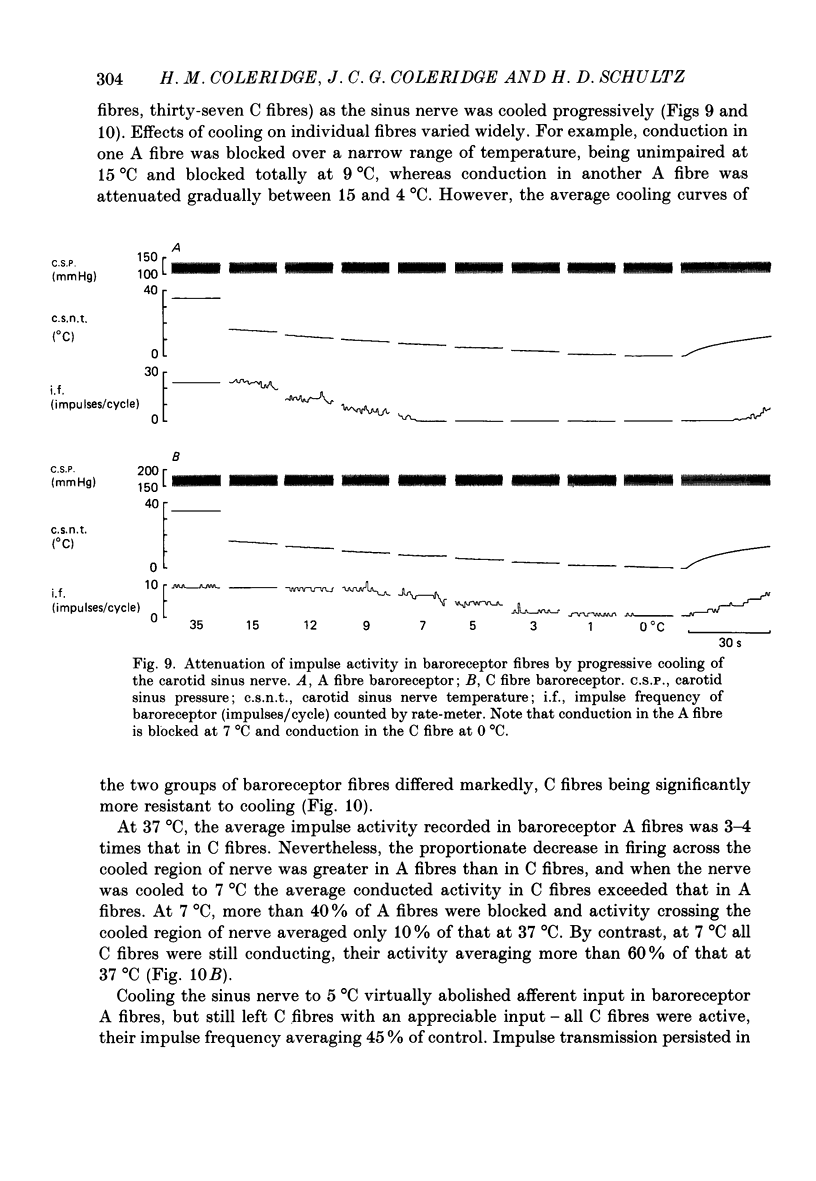
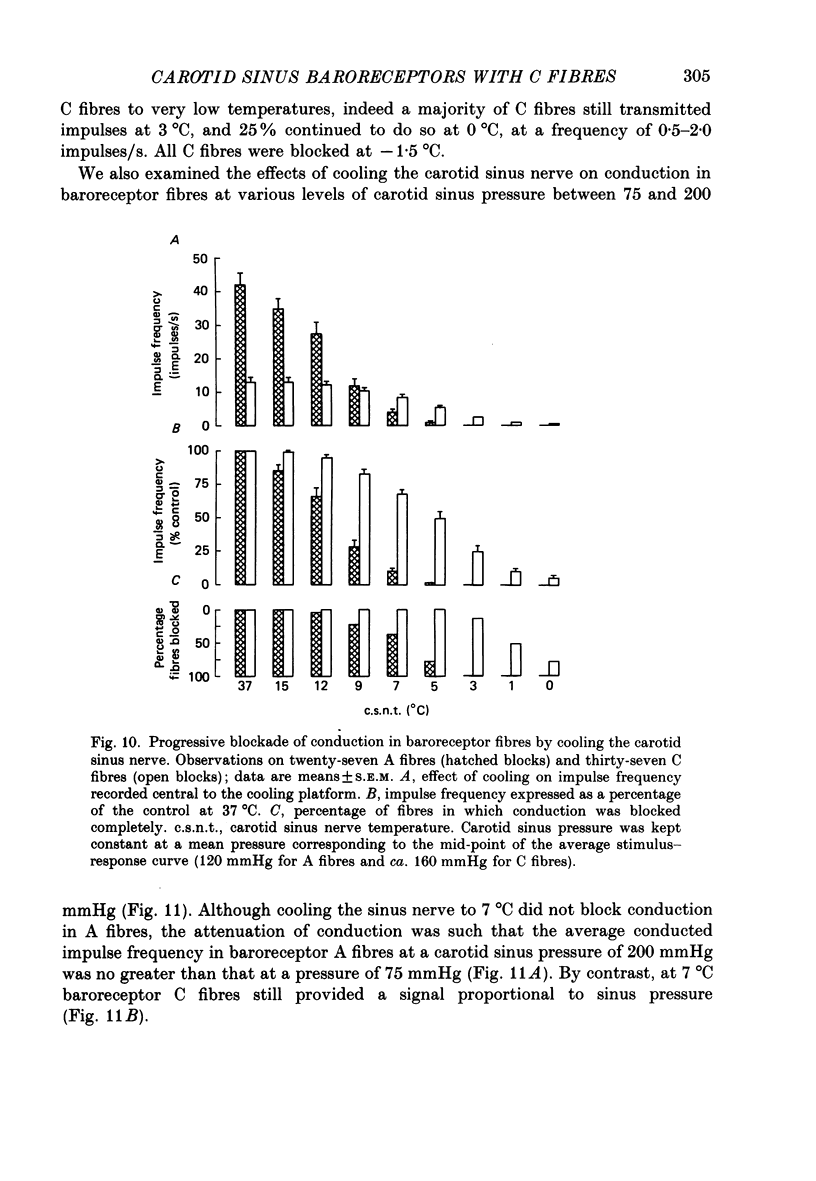
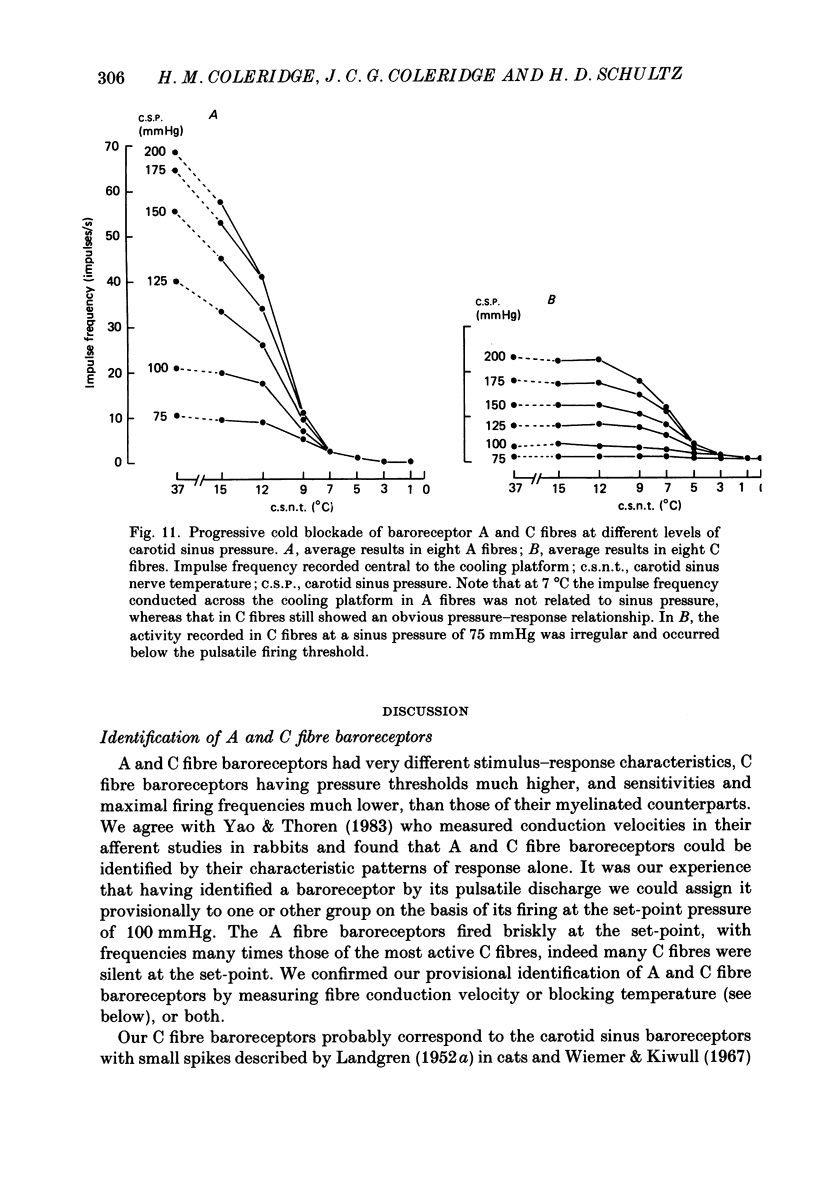
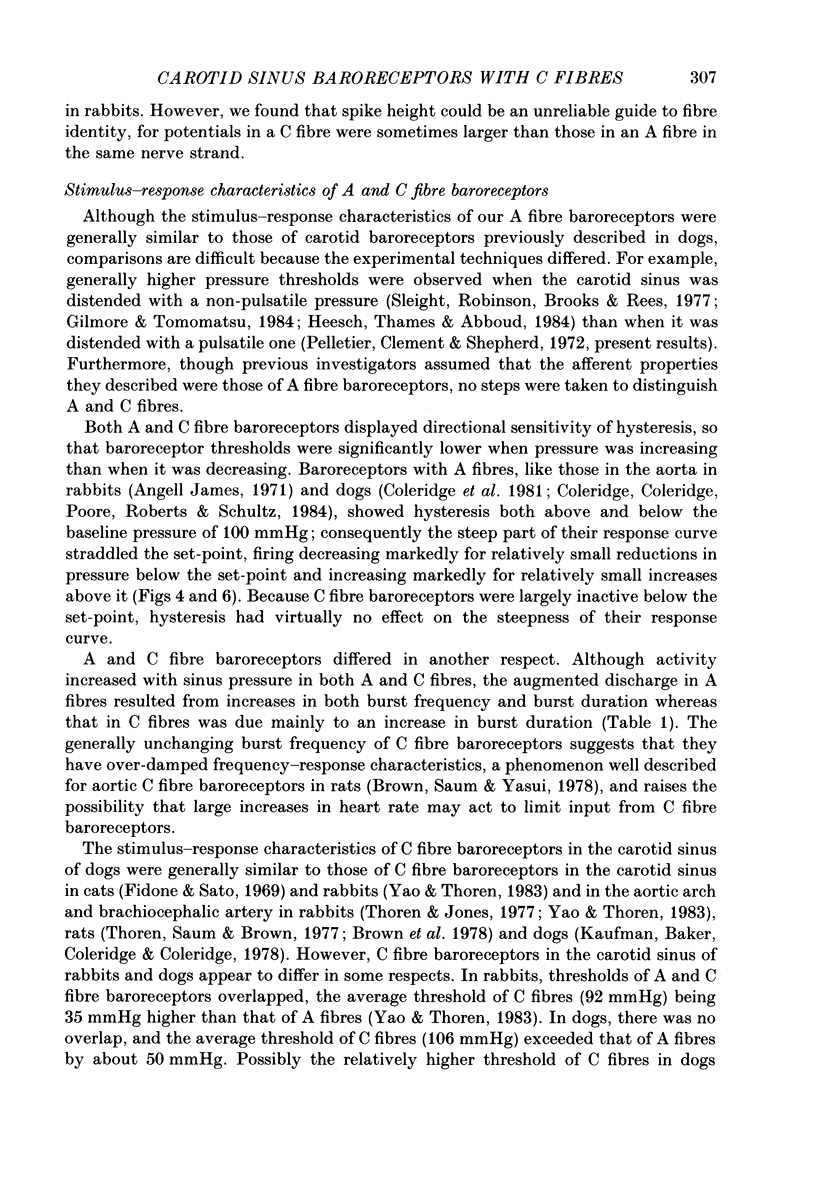
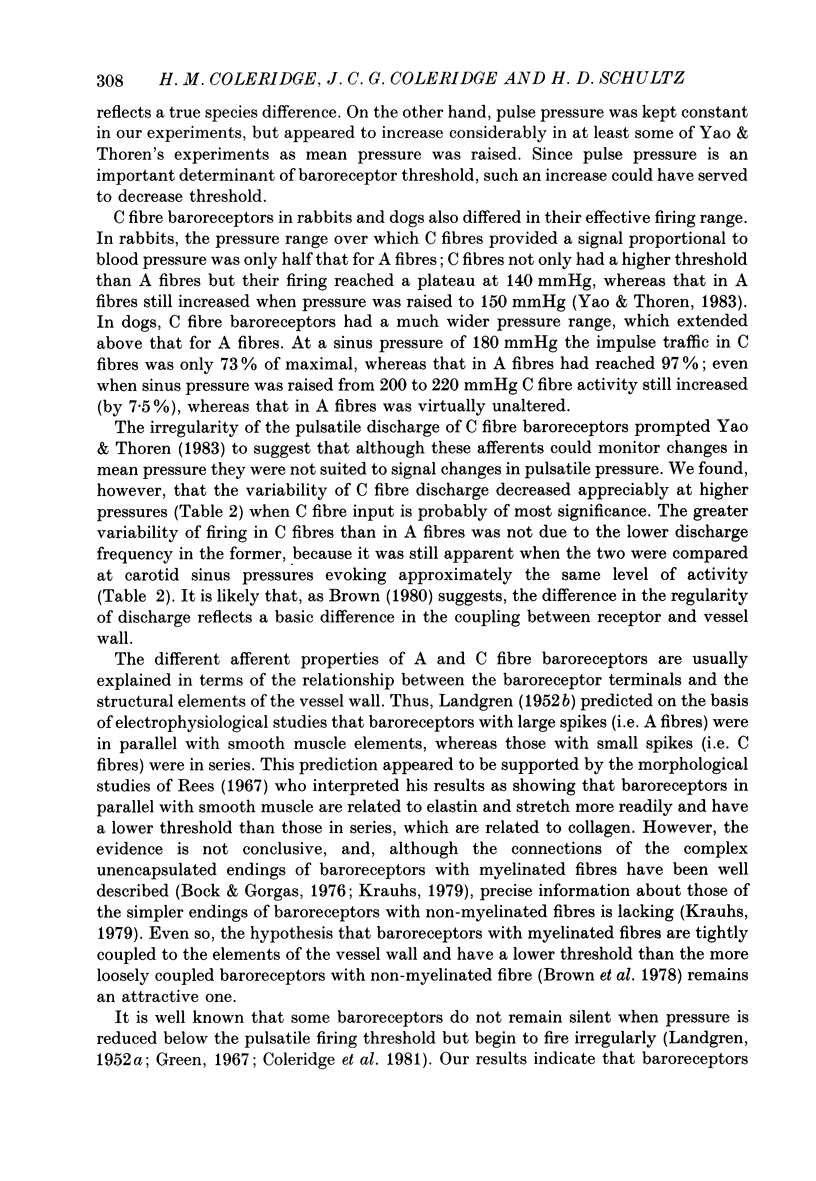
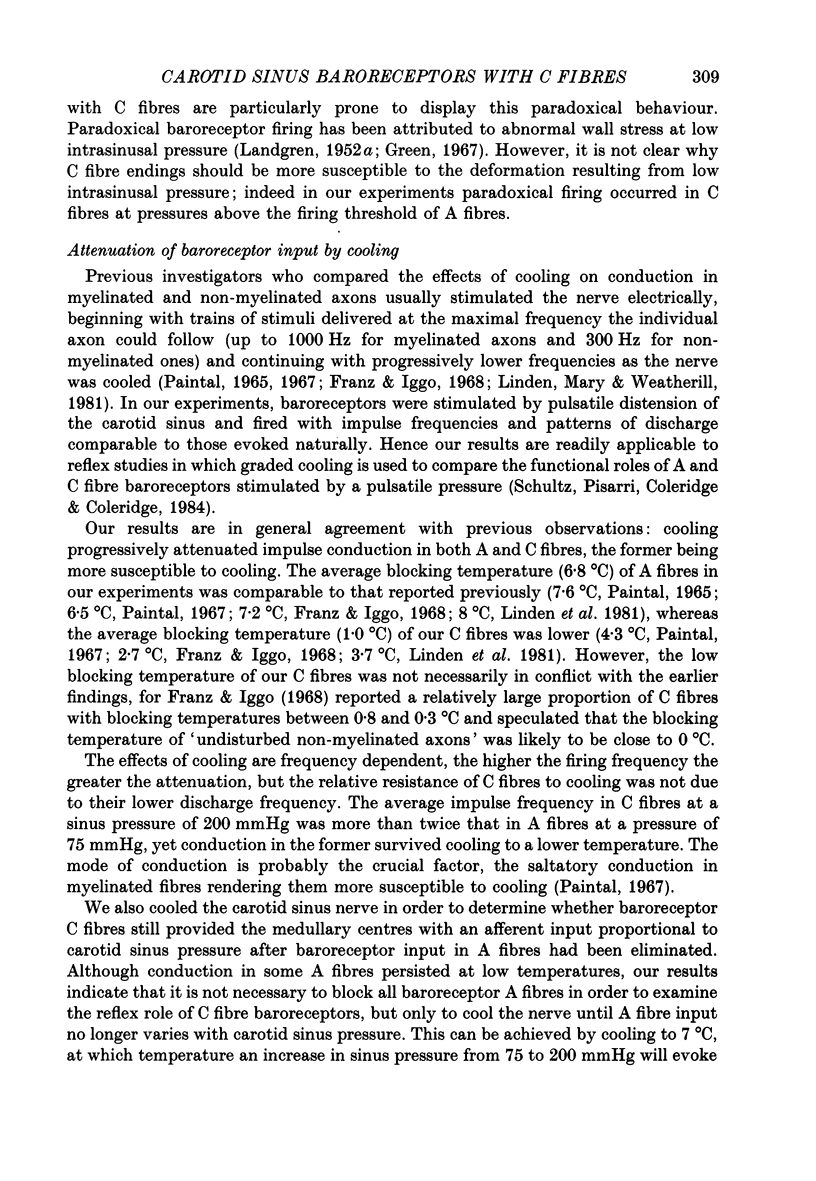
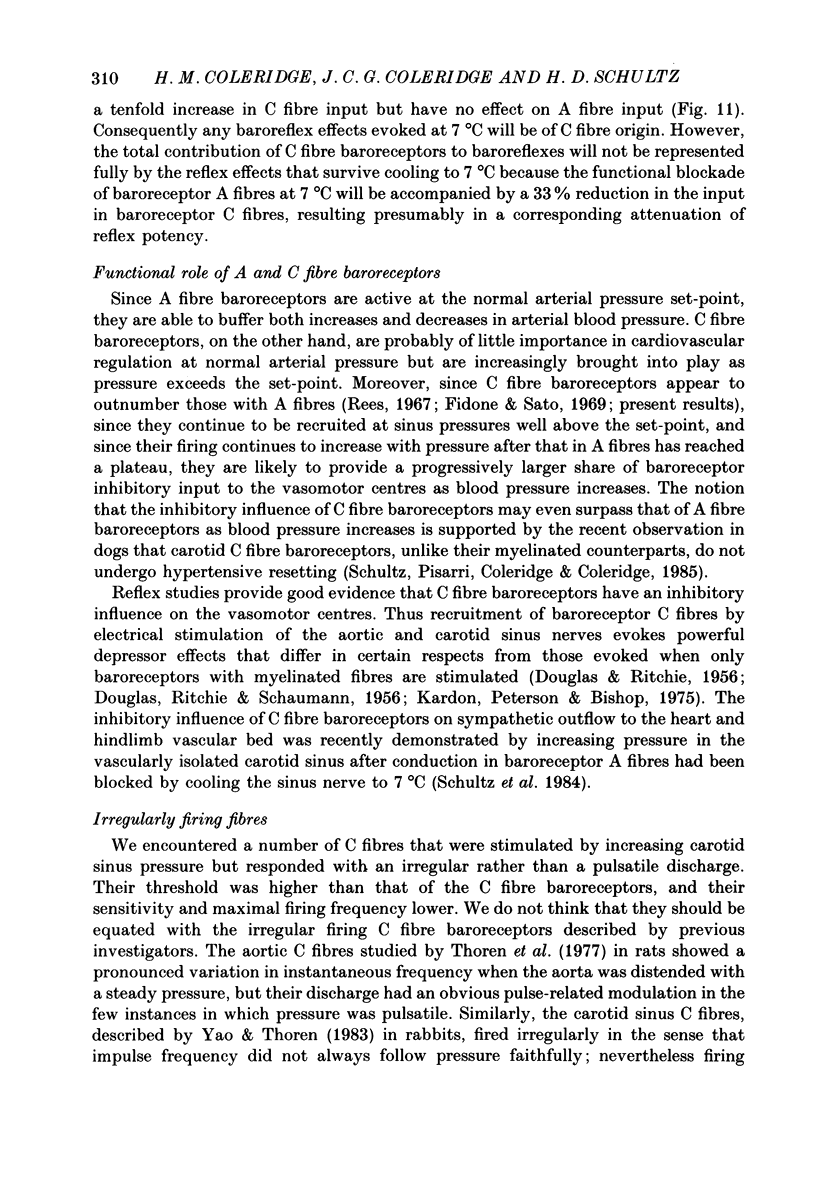

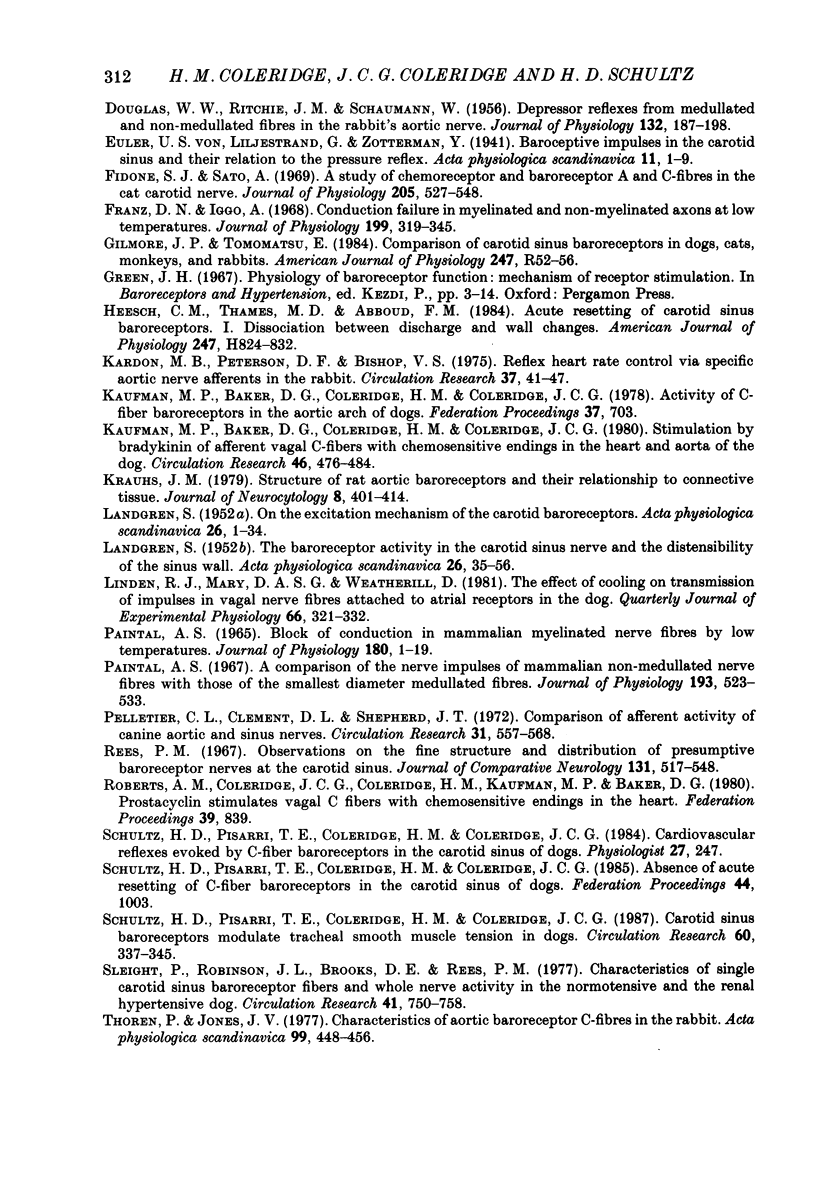
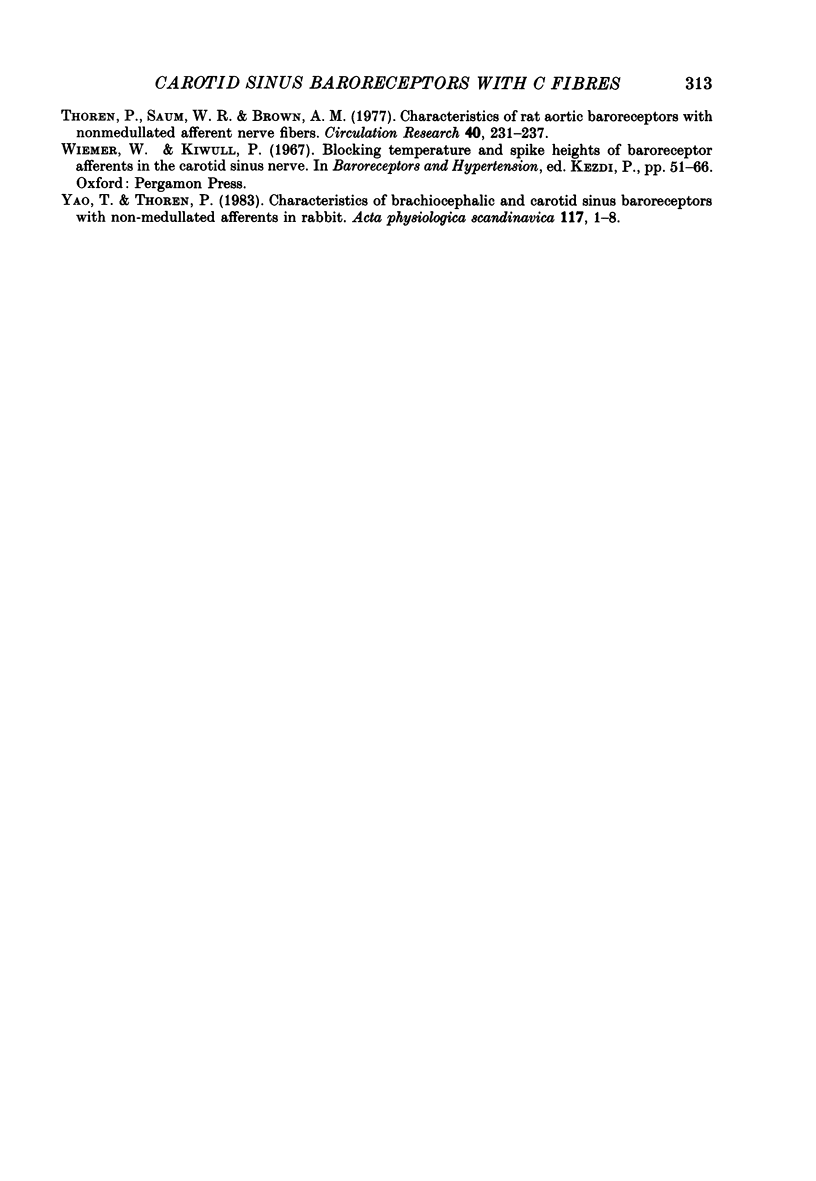
Selected References
These references are in PubMed. This may not be the complete list of references from this article.
- Angell James J. E. The effects of altering mean pressure, pulse pressure and pulse frequency on the impulse activity in baroreceptor fibres from the aortic arch and right subclavian artery in the rabbit. J Physiol. 1971 Apr;214(1):65–88. doi: 10.1113/jphysiol.1971.sp009419. [DOI] [PMC free article] [PubMed] [Google Scholar]
- Brown A. M. Receptors under pressure. An update on baroreceptors. Circ Res. 1980 Jan;46(1):1–10. doi: 10.1161/01.res.46.1.1. [DOI] [PubMed] [Google Scholar]
- Brown A. M., Saum W. R., Yasui S. Baroreceptor dynamics and their relationship to afferent fiber type and hypertension. Circ Res. 1978 May;42(5):694–702. doi: 10.1161/01.res.42.5.694. [DOI] [PubMed] [Google Scholar]
- Böck P., Gorgas K. Fine structure of baroreceptor terminals in the carotid sinus of guinea pigs and mice. Cell Tissue Res. 1976 Jul 20;170(1):95–112. doi: 10.1007/BF00220113. [DOI] [PubMed] [Google Scholar]
- COLERIDGE H. M., COLERIDGE J. C., KIDD C. CARDIAC RECEPTORS IN THE DOG, WITH PARTICULAR REFERENCE TO TWO TYPES OF AFFERENT ENDING IN THE VENTRICULAR WALL. J Physiol. 1964 Nov;174:323–339. doi: 10.1113/jphysiol.1964.sp007490. [DOI] [PMC free article] [PubMed] [Google Scholar]
- Coleridge H. M., Coleridge J. C., Dangel A., Kidd C., Luck J. C., Sleight P. Impulses in slowly conducting vagal fibers from afferent endings in the veins, atria, and arteries of dogs and cats. Circ Res. 1973 Jul;33(1):87–97. doi: 10.1161/01.res.33.1.87. [DOI] [PubMed] [Google Scholar]
- Coleridge H. M., Coleridge J. C., Kaufman M. P., Dangel A. Operational sensitivity and acute resetting of aortic baroreceptors in dogs. Circ Res. 1981 May;48(5):676–684. doi: 10.1161/01.res.48.5.676. [DOI] [PubMed] [Google Scholar]
- Coleridge H. M., Coleridge J. C., Poore E. R., Roberts A. M., Schultz H. D. Aortic wall properties and baroreceptor behaviour at normal arterial pressure and in acute hypertensive resetting in dogs. J Physiol. 1984 May;350:309–326. doi: 10.1113/jphysiol.1984.sp015203. [DOI] [PMC free article] [PubMed] [Google Scholar]
- DOUGLAS W. W., RITCHIE J. M. Cardiovascular reflexes produced by electrical excitation of non-medullated afferents in the vagus, carotid sinus and aortic nerves. J Physiol. 1956 Oct 29;134(1):167–178. doi: 10.1113/jphysiol.1956.sp005632. [DOI] [PMC free article] [PubMed] [Google Scholar]
- DOUGLAS W. W., RITCHIE J. M., SCHAUMANN W. Depressor reflexes from medullated and non-medullated fibres in the rabbits aortic nerve. J Physiol. 1956 Apr 27;132(1):187–198. doi: 10.1113/jphysiol.1956.sp005513. [DOI] [PMC free article] [PubMed] [Google Scholar]
- Federation of American Societies for Experimental Biology. 64th Annual Meeting. Anaheim, California. April 13--18, 1980. Abstracts of papers. 3014--4925. Fed Proc. 1980 Mar 1;39(3 Pt 2):839–1403. [PubMed] [Google Scholar]
- Fidone S. J., Sato A. A study of chemoreceptor and baroreceptor A and C-fibres in the cat carotid nerve. J Physiol. 1969 Dec;205(3):527–548. doi: 10.1113/jphysiol.1969.sp008981. [DOI] [PMC free article] [PubMed] [Google Scholar]
- Franz D. N., Iggo A. Conduction failure in myelinated and non-myelinated axons at low temperatures. J Physiol. 1968 Dec;199(2):319–345. doi: 10.1113/jphysiol.1968.sp008656. [DOI] [PMC free article] [PubMed] [Google Scholar]
- Heesch C. M., Thames M. D., Abboud F. M. Acute resetting of carotid sinus baroreceptors. I. Dissociation between discharge and wall changes. Am J Physiol. 1984 Nov;247(5 Pt 2):H824–H832. doi: 10.1152/ajpheart.1984.247.5.H824. [DOI] [PubMed] [Google Scholar]
- Kardon M. B., Peterson D. F., Bishop V. S. Reflex heart rate control via specific aortic nerve afferents in the rabbit. Circ Res. 1975 Jul;37(1):41–47. doi: 10.1161/01.res.37.1.41. [DOI] [PubMed] [Google Scholar]
- Kaufman M. P., Baker D. G., Coleridge H. M., Coleridge J. C. Stimulation by bradykinin of afferent vagal C-fibers with chemosensitive endings in the heart and aorta of the dog. Circ Res. 1980 Apr;46(4):476–484. doi: 10.1161/01.res.46.4.476. [DOI] [PubMed] [Google Scholar]
- Krauhs J. M. Structure of rat aortic baroreceptors and their relationship to connective tissue. J Neurocytol. 1979 Aug;8(4):401–414. doi: 10.1007/BF01214800. [DOI] [PubMed] [Google Scholar]
- LANDGREN S. On the excitation mechanism of the carotid baroceptors. Acta Physiol Scand. 1952 Jul 17;26(1):1–34. doi: 10.1111/j.1748-1716.1952.tb00889.x. [DOI] [PubMed] [Google Scholar]
- LANDGREN S. The baroceptor activity in the carotid sinus nerve and the distensibility of the sinus wall. Acta Physiol Scand. 1952 Jul 17;26(1):35–56. doi: 10.1111/j.1748-1716.1952.tb00890.x. [DOI] [PubMed] [Google Scholar]
- Linden R. J., Mary D. A., Weatherill D. The effect of cooling on transmission of impulses in vagal nerve fibres attached to atrial receptors in the dog. Q J Exp Physiol. 1981 Jul;66(3):321–332. doi: 10.1113/expphysiol.1981.sp002562. [DOI] [PubMed] [Google Scholar]
- Paintal A. S. A comparison of the nerve impulses of mammalian non-medullated nerve fibres with those of the smallest diameter medullated fibres. J Physiol. 1967 Dec;193(3):523–533. doi: 10.1113/jphysiol.1967.sp008376. [DOI] [PMC free article] [PubMed] [Google Scholar]
- Paintal A. S. Block of conduction in mammalian myelinated nerve fibres by low temperatures. J Physiol. 1965 Sep;180(1):1–19. [PMC free article] [PubMed] [Google Scholar]
- Pelletier C. L., Clement D. L., Shepherd J. T. Comparison of afferent activity of canine aortic and sinus nerves. Circ Res. 1972 Oct;31(4):557–568. doi: 10.1161/01.res.31.4.557. [DOI] [PubMed] [Google Scholar]
- Rees P. M. Observations on the fine structure and distribution of presumptive baroreceptor nerves at the carotid sinus. J Comp Neurol. 1967 Dec;131(4):517–548. doi: 10.1002/cne.901310409. [DOI] [PubMed] [Google Scholar]
- Schultz H. D., Pisarri T. E., Coleridge H. M., Coleridge J. C. Carotid sinus baroreceptors modulate tracheal smooth muscle tension in dogs. Circ Res. 1987 Mar;60(3):337–345. doi: 10.1161/01.res.60.3.337. [DOI] [PubMed] [Google Scholar]
- Sleight P., Robinson J. L., Brooks D. E., Rees P. M. Characteristics of single carotid sinus baroreceptor fibers and whole nerve activity in the normotensive and the renal hypertensive dog. Circ Res. 1977 Dec;41(6):750–758. doi: 10.1161/01.res.41.6.750. [DOI] [PubMed] [Google Scholar]
- Thoren P., Jones J. V. Characteristics of aortic baroreceptor C-fibres in the rabbit. Acta Physiol Scand. 1977 Apr;99(4):448–456. doi: 10.1111/j.1748-1716.1977.tb10397.x. [DOI] [PubMed] [Google Scholar]
- Thorén P., Saum W. R., Brown A. M. Characteristics of rat aortic baroreceptors with nonmedullated afferent nerve fibers. Circ Res. 1977 Mar;40(3):231–237. doi: 10.1161/01.res.40.3.231. [DOI] [PubMed] [Google Scholar]


